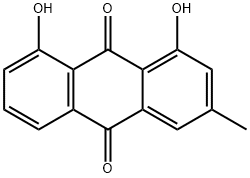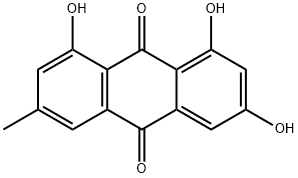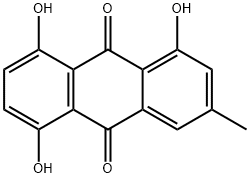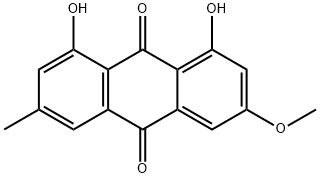Chrysophanic acid
Synonym(s):1,8-Dihydroxy-3-methylanthraquinone;3-Methylchrysazin;Chrysophanic acid
- CAS NO.:481-74-3
- Empirical Formula: C15H10O4
- Molecular Weight: 254.24
- MDL number: MFCD00001208
- EINECS: 207-572-2
- SAFETY DATA SHEET (SDS)
- Update Date: 2024-05-24 18:18:52

What is Chrysophanic acid?
Description
Chrysophanol is an anthraquinone that has been found in R. palmatum and has diverse biological activities. It induces necrosis in J5 human liver cancer cells when used at concentrations of 25, 50, 75, 100, and 200 μM. Chrysophanol (5, 10, and 50 μM) reduces LPS-induced production of nitric oxide (NO) and prostaglandin E2 (PGE2; ) and inhibits LPS-induced DNA oxidation in BV-2 microglia. In vivo, chrysophanol (5 mg/kg) decreases colonic levels of IL-6 and activation of NF-κB and reduces weight loss, diarrhea, and rectal bleeding in a mouse model of colitis induced by dextran sulfate (DSS; ). Chrysophanol (0.1, 1, and 10 mg/kg) increases survival, reduces brain tissue loss, and ameliorates motor balance deficits in a mouse model of ischemia-reperfusion injury induced by middle cerebral artery occlusion (MCAO).
The Uses of Chrysophanic acid
Chrysophanic acid, a natural anthraquinone, is used to study anticancer activity in EGFR-overexpressing SNU-C5 human colon cancer cells 1. It is also used to study the inhibition of replication of poliovirus types 2 and 3 (Picornaviridae) in vitro 2.
What are the applications of Application
Chrysophanol is an inducer of intracellular Ca2+ concentration and exhibit antifungal activities
Properties of Chrysophanic acid
| Melting point: | 194-198 °C |
| Boiling point: | 357.45°C (rough estimate) |
| Density | 1.2693 (rough estimate) |
| storage temp. | Inert atmosphere,Room Temperature |
| solubility | chloroform: soluble1% |
| form | crystalline |
| color | yellow-orange |
| Water Solubility | <0.1 g/100 mL at 18 ºC |
Safety information for Chrysophanic acid
| Signal word | Warning |
| Pictogram(s) |
 Exclamation Mark Irritant GHS07 |
| GHS Hazard Statements |
H315:Skin corrosion/irritation H319:Serious eye damage/eye irritation H335:Specific target organ toxicity, single exposure;Respiratory tract irritation |
| Precautionary Statement Codes |
P261:Avoid breathing dust/fume/gas/mist/vapours/spray. P264:Wash hands thoroughly after handling. P264:Wash skin thouroughly after handling. P271:Use only outdoors or in a well-ventilated area. P280:Wear protective gloves/protective clothing/eye protection/face protection. P302+P352:IF ON SKIN: wash with plenty of soap and water. P305+P351+P338:IF IN EYES: Rinse cautiously with water for several minutes. Remove contact lenses, if present and easy to do. Continuerinsing. |
Computed Descriptors for Chrysophanic acid
New Products
3-N-BOC-(S)-AMINO BUTYRONITRILE 4-Piperidinopiperidine 2-Methyl-4-nitrobenzoic acid 2-(4-bromophenyl)-2-methylpropanoic acid 4-Acetyl-2-methylbenzoicacid Acetyl-meldrum's acid Ethyl-4-Pyrazole carboxylate 2,6 Di acetylpyridine 2,6-Pyridinedimethanol 5,7-Dichloro-3H-Imidazo[4,5-B]Pyridine 5-Bromo-2-Methoxy-4-Methyl-3-Nitropyridine 2-Fluoro-5-Iodopyridine 2-Fluoro-5-Methylpyridine 2-Chloro-3-Bromo-5-Amiopyridine METHYL-4-(BUTYRYLAMINO)3-METHYL-5-NITROBENZOATE TRANS-CYCLOBUTANE-1,2- DICARBOXYLIC ACID 5-Nitro indazole R-(-)-5-(2-AMINO-PROPYL)-2-METHOXY-BENZENESULFONAMIDE 1,3-cyclohexanedione 4-Aminophenaethylalchol (S)-(+)-4-BENZYL-2-OXAZOLIDINONE 3-NITRO-5-ACETYL IMINODIBENZYL 4-FLUORO PHENYL MAGNESIUM BROMIDE 1.0 M IN THF 1-HYDROXY-4-METHYL6-(2,4,4-TRI METHYL PHENYL)-2-PYRIDONE MONO ETHANOL AMINE(PIROCTONE OLAMINE)Related products of tetrahydrofuran








You may like
-
 2,3 Dichloro-4-Hydroxy Aniline 39183-17-0 99%View Details
2,3 Dichloro-4-Hydroxy Aniline 39183-17-0 99%View Details
39183-17-0 -
 17673-56-2 99%View Details
17673-56-2 99%View Details
17673-56-2 -
 13463-67-7 Titanium Dioxide 99%View Details
13463-67-7 Titanium Dioxide 99%View Details
13463-67-7 -
 143-07-7 99%View Details
143-07-7 99%View Details
143-07-7 -
 Ethanolamine 141-43-5 99%View Details
Ethanolamine 141-43-5 99%View Details
141-43-5 -
 616-47-7 99%View Details
616-47-7 99%View Details
616-47-7 -
 20776-67-4 99%View Details
20776-67-4 99%View Details
20776-67-4 -
 acid blue 113, acid navy blue , wool navy blue 0View Details
acid blue 113, acid navy blue , wool navy blue 0View Details
3351-05-1